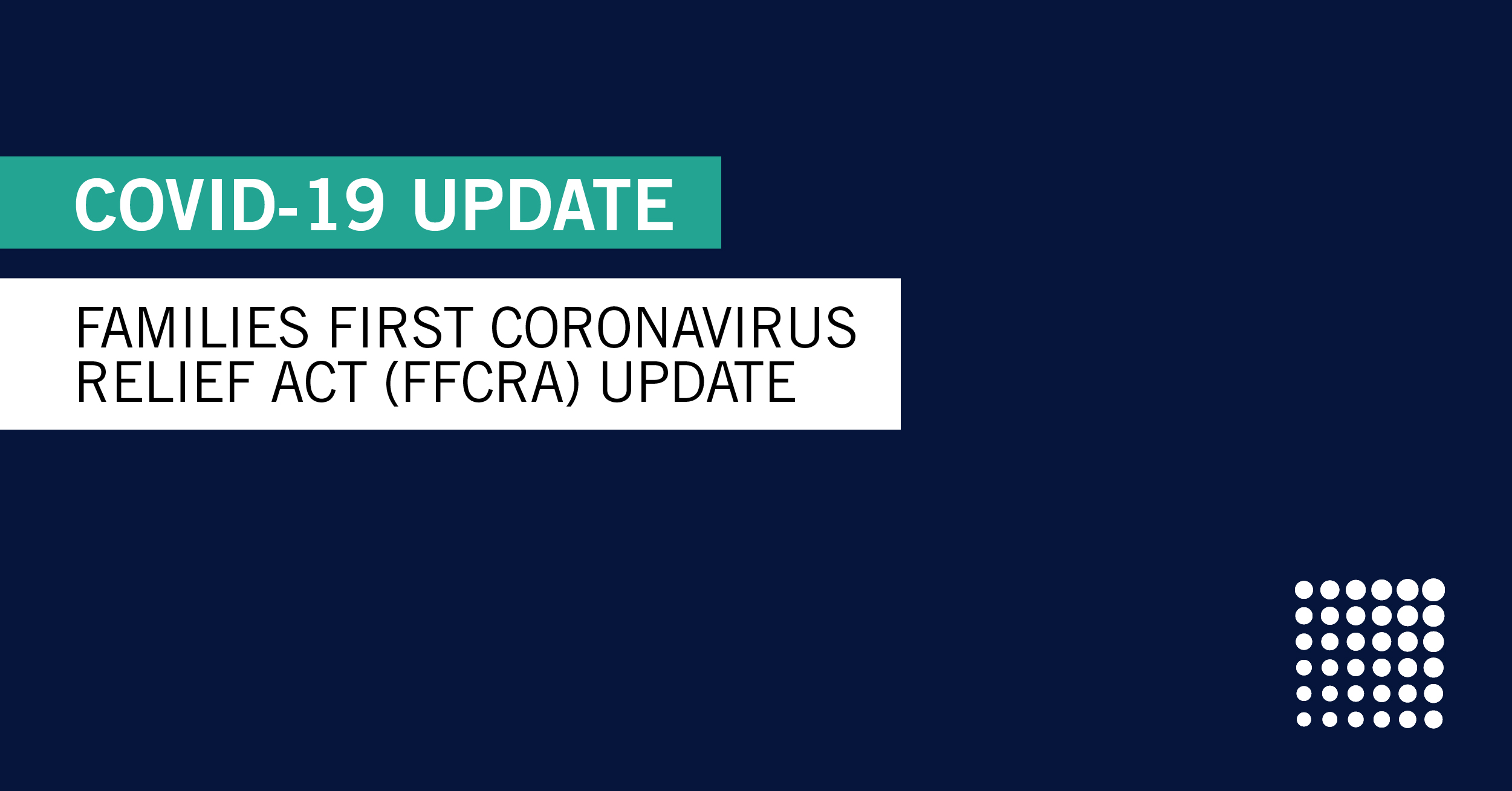The fine print on paid sick leave, tax credit information and more.
The Families First Coronavirus Relief Act (FFCRA) was the first piece of Coronavirus-related legislation enacted by our government in mid-March. In a March 19 blog, our advisors took a look at the legislation, detailing paid sick-leave benefits for both employers and employees. Since most dental practices were forced to shut down prior to the FFCRA going into effect, many have not had to comply with this new rule until now.
Now that dental practices are reopening, the relevancy of this act has reemerged, as it’s likely some offices will have employees who qualify for paid sick leave under the terms of the FFCRA.
This blog will review the two types of paid leave employers may be required to pay as employees begin to return to work in the coronavirus environment. This applies to all employers with fewer than 500 employees. There are few exemptions, those of which will be referenced below. The associated tax credits for these required leave benefits will also be covered.
PAID SICK LEAVE
Employee eligibility: This “sick pay” benefit is available to all employees of covered employers if they meet one of the following conditions, requiring their absence from work:
- To self-isolate because the employee has been diagnosed with coronavirus;
- To seek a diagnosis or preventative care for coronavirus because the employee is exhibiting symptoms;
- To comply with a recommendation or order by a public official or healthcare provider on the basis that the physical presence of the employee on the job would jeopardize the health of others;
- To care for a family member who is quarantining due to diagnosis, exhibiting symptoms or need to seek medical care; or
- To care for their own child (children) whose school has closed, or if a childcare provider is unavailable due to the coronavirus.
Benefits provided: During a public health emergency, including the current coronavirus pandemic, an employer must provide an employee with up to 80 hours of paid sick leave.
If the employee is eligible under conditions 1 through 3, pay would be at the employee’s regular rate of pay (up to a maximum of $511 per day). The maximum $511 rate of pay is the equivalent of an annual salary of $132,860, resulting in most dental practice employees receiving their full pay.
For employees eligible under conditions 4 through 5, pay would be at a rate of two-thirds up to a maximum amount of $200 per day. At the two-thirds pay rate, one would have earn $37.50 per hour to receive the maximum of $200 per day, resulting in most dental practice employees receiving only two-thirds or regular pay.
Part-time employees are entitled to the normal number of hours that they work in a typical two-week period. For employees that work irregular schedules, the employer should use the average hours worked over the past 6 months.
Family Medical Leave Expansion Act (FMLEA)
Employee eligibility: This “leave pay” benefit is available to all employees of covered employers who have worked for the employer for at least 30-days prior to the designated leave, and meet the following condition, requiring their absence from work, or inability to telework:
- To care for their own child (children) whose school has closed, or if a childcare provider is unavailable due to the coronavirus.
Benefits provided: During a public health emergency, including the current coronavirus pandemic, an employer is required to offer the following:
- Unpaid leave for the first 10 days; alternatively, the employee may elect to use any existing accrued paid leave (vacation pay or accrued sick pay) during this period.
- Starting on day 11 and continuing for up to 10 weeks, the employer must provide the employee with paid leave at two-thirds of the employee’s regular rate (up to a maximum of $200 per day or $10,000 in aggregate per employee).
Part-time employees are entitled to be paid two-thirds of their regular rate based on the average number of hours worked per week over the past 6 months.
Exemptions: An employer that has less than 50 employees may be exempt from the provisions of the FFCRA, and the corresponding sick pay or leave pay rules. This exemption only applies when an employee is unable to work because they must care for their own child because a childcare provider is unavailable due to the coronavirus. The employer must also meet any of the following conditions:
- Complying with the FFCRA would result in the small business’ expenses and financial obligations exceeding available business revenues and cause the small business to cease operating at a minimal capacity;
- The absence of the employee or employees requesting paid sick leave or expanded family and medical leave would entail a substantial risk to the financial health or operational capabilities of the small business because of their specialized skills, knowledge of the business, or responsibilities; or
- There are not sufficient workers who are able, willing and qualified, and who will be available at the time and place needed, to perform the labor or services provided by the employee or employees requesting paid sick leave or expanded family and medical leave, and these labor or services are needed for the small business to operate at a minimal capacity.
Telework implications: In general, employees that are able to telework, even at reduced hours, are not eligible for either of the above paid sick leave or FMLEA pay.
If an employee is unable to telework due to one of the qualifying reasons for paid sick leave, then he or she is entitled to paid sick leave. Similarly, if the employee is unable to telework due to leave pay qualifying reasons, that employee is eligible for leave pay. If mutually agreed-upon by the employee and the employer, an employee could be paid partial leave (based on the rules above) if they can telework but at a reduced schedule.
Tax Credit
The FFCRA provides a refundable credit to employers who are required to payout either of the above sick pay or leave pay. The tax credits are dollar-for-dollar, corresponding with the requirements above and are limited to the maximum daily amount limits. The credit will be taken on the federal quarterly payroll tax returns (Form 941) each quarter.
If you use a third-party payroll provider, you will want to notify them when you pay out sick pay or leave pay wages, in order for them to track this pay separately. Your payroll provider should be able to handle tracking and recording the wages and associated tax credit appropriately.
CWA insights: As offices are beginning to reopen, situations where an employee or relative has contracted the virus, or employees are unable to find childcare, is becoming more common. In situations such as these, it is important to understand that employers (even those with fewer than 50 employees) may have a requirement under one of the above sick pay or leave pay rules. If any of the qualifying reasons is met and the employer must pay these wages, the employer will recover sick pay or leave pay wages paid in the form of a tax credit, as described above.
In most situations, under the leave pay rules (FMLEA), a small business is exempt from certain paid sick leave and expanded family and medical leave requirements if the employer employs fewer than 50 employees, as referenced above. CWA practices under 50 employees should claim this exemption, as requiring to pay leave pay for 10-weeks would materially impact practice operations and financial health. Please note: some practices under 50 employees would still not likely qualify for the exemption – if this becomes an issue for your practice, or you are unsure if your practice qualifies for the exemption, reach out to your CWA advisor for guidance.
For sick pay rules, since the time period is much shorter, practices would be required to pay sick pay wages as dictated by the FFCRA, regardless of practice size. In this case we advise filing to receive the tax credit for the wages paid, and continue normal business operation.
It is important to note that an employee is limited to 80 hours of paid sick leave through Dec. 31, 2020. Therefore, if an employee is out for a qualifying sick pay reason for less than 10 days initially and then again later in the year, the maximum total days the employee would be eligible for under this provision would be 10 days.
Every situation is unique, please work with your CWA advisor and HR compliance advisor or employment attorney to determine how these rules apply to each individual situation you encounter.
WEBINAR COMING SOON:
“Navigating Personnel Issues and Maximizing Loan Forgiveness: A Discussion on the PPPFA and FFRCA Strategies for Business Owners” with presenters CWA Partner Dan Wicker and CEDR HR Solutions CEO Paul Edwards.
Check the COVID-19 Resources Page for this On-Demand Webinar Tuesday, June 16.














